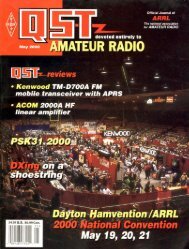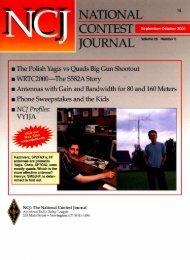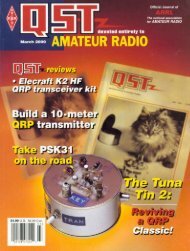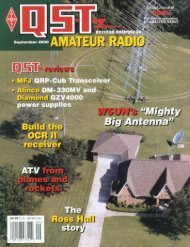You also want an ePaper? Increase the reach of your titles
YUMPU automatically turns print PDFs into web optimized ePapers that Google loves.
accessory jack LINE input. If you’re using<br />
your rig’s accessory connector as the<br />
modulation input to your transceiver, connecting<br />
a microphone to the interface’s MIC<br />
HOT pad (as described earlier) isn’t necessary<br />
as the mic is likely connected directly<br />
to the rig’s mic connector.<br />
• SC LINE OUT—Input from the sound card<br />
LINE OUTPUT jack (high side).<br />
• +10 to +15 V—External power-supply connection.<br />
Serial-port connection labels are on the<br />
component side of the PC board opposite<br />
the rig and sound card I/Os. Pin numbers<br />
indicated are those for a 9-pin (DB9) connector<br />
at J1. If you have a 25-pin serial port<br />
connection, use the pin numbers enclosed<br />
in parentheses in Figure 1.<br />
Summary<br />
Now you have no excuse for not trying<br />
AMTOR, FAX, Hellschreiber, MT63,<br />
PACTOR, PSK31, RTTY and SSTV. With<br />
this interface, you can operate most of the<br />
modes by simply running the appropriate<br />
software (much of which is free) and selecting<br />
the proper interface. You’re sure to<br />
have fun!<br />
Notes<br />
1<br />
K7SZL’s Unofficial HamComm home page<br />
(http://home.att.net/~k7szl) contains information<br />
on nearly every aspect of the popular<br />
HamComm program.<br />
2<br />
The JV-FAX/JV-Comm32 site is http://www.<br />
jvcomm.de.<br />
3<br />
Most sound card SSTV and other digitalmode<br />
software can be found at http://<br />
www.muenster.de/~welp/sb.htm.<br />
4<br />
For PSK31 information and software, visit the<br />
“Official” PSK31 Homepage at http://aintel.<br />
bi.ehu.es/psk31.html.<br />
5 Information on the MT63 experimental mode<br />
and software can be found at http://<br />
members.xoom.com/ZL1BPU/MT63/<br />
MT63.html.<br />
6<br />
All of these DOS SSTV programs (EZ-SSTV,<br />
GSH-PC, JV-FAX, and MSCAN) in addition<br />
to most sound card SSTV software can be<br />
obtained from http://www.ultranet.com/<br />
~sstv/index.html. The EZ-SSTV site is<br />
http://www.ultranet.com/~sstv/<br />
ezsstv.html. MSCAN is available from http:<br />
//www.mscan.com.<br />
7<br />
You can download EasyFAX V1.10 from ftp:<br />
//ftp.funet.fi/pub/ham/fax_sstv<br />
/ef110.exe.<br />
8 GSH-PC is available at http://ourworld.<br />
compuserve.com/homepages/dl4saw<br />
and http://www.pervisell.com/ham/gs1.<br />
htm.<br />
9<br />
PC boards are available from Far Circuits,<br />
18N640 Field Ct, Dundee, IL 60118-9269;<br />
tel 847-836-9148 (voice and fax); http://<br />
www.cl.ais.net/farcir/. PC Board only, $5<br />
plus $1.50 shipping for up to four boards.<br />
Visa and MasterCard accepted with a $3<br />
service charge.<br />
Jim Mitrenga, N9ART, received his Technician<br />
class license in March of 1979; he upgraded to<br />
Amateur Extra class in 1981. Jim’s wife, Sandy,<br />
is KB9MXF. Jim and Sandy are active on VHF<br />
and UHF FM for family communication. HF<br />
CW is Jim’s favorite mode, but he’s active on<br />
AM, FM, SSB, SSTV, PSK31, RTTY and packet,<br />
and enjoys Amateur Radio electronics design.<br />
Jim’s other interests include fishing, hiking, bicycling,<br />
gardening, computers, audio recording<br />
and broadcast engineering. Jim is employed as<br />
a program manager at Motorola, Inc, in<br />
Schaumburg, Illinois, where he started as an RF<br />
design engineer in 1979. Currently he concentrates<br />
on digital communications audio quality.<br />
You can contact Jim at 1013 Chippewa Dr,<br />
Elgin, IL 60120; sstv@hotmail.com and<br />
n9art@arrl.net.<br />
NEW BOOKS<br />
THE ELECTRONICS OF RADIO<br />
By David B. Rutledge, KN6EK<br />
Published by Cambridge University Press, 40<br />
West 20th Street, New York NY 10011-4211;<br />
tel 212-924-3900; fax 212-691-3239; http://<br />
www.cup.org. First edition, 1999, 431 pages<br />
including the index, paperback 10 × 6 7 /8<br />
inches, B&W illustrations, 3 1 /2-inch disk included.<br />
ISBN 0521646456. $44.95.<br />
Reviewed by TA Paul Danzer, N1II<br />
ARRL Technical Advisor<br />
◊ The Electronics of Radio is a college-level<br />
textbook, and the author is a professor of<br />
electrical engineering at the California<br />
Institute of Technology. There is a good deal<br />
of mathematics in many of the chapters, and<br />
knowledge of basic first-year calculus would<br />
be helpful to understand some of the material.<br />
This being the case, why would this book<br />
be of interest to many hams Because there<br />
are some real goodies between the soft covers<br />
of an attractive, well-written text using the<br />
NorCal 40A QRP rig as its example.<br />
The first chapter is a summary of radio<br />
⎯from the Titanic through basic electrical<br />
laws, receiver and transmitter components<br />
and stages, up to the NorCal rig. From this<br />
point onward the following chapters are<br />
more conventional⎯components, transmission<br />
lines, filters, amplifiers and so on. But<br />
included in here are any number of<br />
interesting sidelights and approaches. As an<br />
example of acoustics, in Chapter 7 there is<br />
42 <strong>November</strong> <strong>2000</strong><br />
a problem (or exercise for the student) using<br />
a resonate tube to change the response of a<br />
loud speaker. Anyone remember some of the<br />
old “Hints And Kinks”<br />
The oscillator chapter of The Electronics<br />
of Radio contains a very nice explanation<br />
of RIT, the NorCal circuit that generated this<br />
function, and a drawing of the components<br />
on the board to show how it is actually built.<br />
For those who like to see actual hardware<br />
along with theory, KN6EK often obliges.<br />
Chapter 12 is devoted to mixers, and there<br />
is a bit of math used. However, for anyone<br />
who is tired of long and inconclusive<br />
discussions of mixers, spurious products and<br />
receiver problems, the material in this<br />
chapter is very much worth<br />
reading. Included is a very precise<br />
explanation of key clicks using a<br />
power spectrum expression ⎯but<br />
with it is a filter and an explanation<br />
of the way the filter works.<br />
The noise chapter a mathematically<br />
based explanation of<br />
what goes on in a receiver. Like<br />
it or not, this is an area where the<br />
math is needed to explain the<br />
operation. Although some<br />
calculus is used, unless you are an engineering<br />
student, you probably won’t miss<br />
much by just passing over the calculus<br />
equations.<br />
Chapter 15, Antennas And Propagation,<br />
contains a very nice section concerning the<br />
Friis Formula. Many technical people will<br />
recognize most of it as the radar range equation,<br />
used to predict how far a radar system<br />
can see a target. Along with it is an explanation<br />
of how to calculate line-of-sight for<br />
VHF, UHF and microwave is an explanation<br />
of why the Earth’s radius is multiplied by<br />
4/3 for calculating line-of-sight.<br />
There are several appendices included.<br />
Appendix B goes through Fourier Series.<br />
But unlike the treatment in most math<br />
handbooks, this one is directed and limited<br />
to radio and electronics applications. The<br />
examples worked out in detail are for a<br />
square wave, rectified cosine (or sine) wave<br />
and narrow pulses.<br />
Another appendix explains the use of<br />
Puff 2.1 and the disk accompanying the<br />
book. Puff 2.1 is a circuit simulator for<br />
linear circuits that also makes microstrip<br />
and stripline layouts. I did not<br />
attempt to use the software.<br />
The final appendix is a very<br />
nice feature I appreciated both as<br />
a reader and teacher ⎯a set of<br />
data sheets for the critical<br />
components used in The<br />
Electronics of Radio, as well as<br />
the Web addresses of many of the<br />
suppliers. Often you see a<br />
transistor or integrated circuit<br />
used in a technical discussion and<br />
you have no clue as to its characteristics.<br />
The appendix thankfully cures this problem.<br />
In summary, The Electronics of Radio<br />
uses the novel approach of making a real ham<br />
rig as the subject of most of its examples. As<br />
a textbook, it is not general light reading for<br />
everyone, but it has a number of goodies in<br />
it, and if you want to see a slightly different<br />
approach to electronics, take a look at The<br />
Electronics of Radio.<br />
Next New Book

















